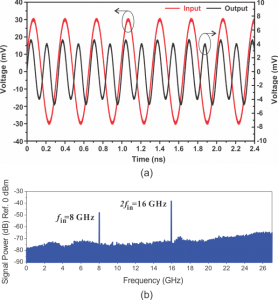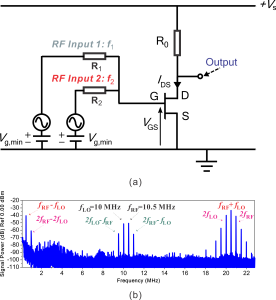Graphene Ambipolar Electronics for RF Applications
- Category: Energy, Nanotechnology
- Tags: Han Wang, Jing Kong, Tomas Palacios
Graphene is a one-atom-thick layer of carbon atoms arranged in a honeycomb lattice through sp2 bonding [1] . Considered for many years an impossible goal, the isolation of graphene triggered a revolution not only among condensed-matter physicists but also among chemists and engineers, eager to take advantage of its unique properties [2] . The symmetry of its honeycomb lattice structure confers to graphene very unique transport properties [3] . For example, the carriers in graphene lose their effective mass and can be described by a Dirac-like equation instead of by the Schrödinger equation used in traditional semiconductors. This very low effective mass is responsible for a very high electron and hole mobility in excess of 100,000 cm2/Vs at room temperature [4] , the highest ever reported for any semiconductor. In this work, we develop novel graphene electronic devices using graphene grown by chemical vapor deposition. These new applications of graphene rely on its ambipolar transport properties to provide unique device level functionalities, which can significantly simplify the designs of many basic RF circuit blocks, such as frequency multipliers and mixers [5] [6] . The new graphene ambipolar frequency multipliers, integrated on a sapphire substrate, can operate at 16 GHz with extremely high output spectral purity (> 90%) (Figure 1) and are the fastest circuit level demonstration ever made using graphene. These Ku-band graphene frequency multipliers, made from wafer-scale graphene synthesis and fabrication processes, show the great potential of graphene-based ambipolar devices for RF and mixed-signal applications. Other applications such as graphene ambipolar mixers (Figure 2) can suppress odd order intermodulations more effectively than in traditional unipolar FET mixers [6]. These graphene devices have great potential for applications in future high performance transparent and flexible electronics.
- Figure 1: (a) Experimental demonstration of frequency doubling measured by an Agilent DSA90604A oscilloscope. The input is at 3 GHz. The output fundamental frequency is 6 GHz. (b) Power spectrum of the output signal from the graphene frequency doublers. The input is at 8 GHz. Frequency doubling is clearly visible. The signal power at fout=2fin=16 GHz is about 10 dB higher than signal power at fout= fin=8 GHz without filtering. More than 90% of the total RF power in the output signal is at 16 GHz. All data are obtained using Agilent N9010A spectrum analyzer.
- Figure 2: (a) Demonstration circuit of graphene ambipolar mixers. (b) Spectrum analysis: Output spectrum with RF input fRF=10.5 MHz and local oscillator fLO=10 MHz at equal power. The presence of strong signal power at fRF – fLO=500 kHz and fRF + fLO=21.5 MHz clearly demonstrates mixing operations. All data are obtained using Agilent N9010A spectrum analyzer, and the measurements were done at room temperature in air.
- K. S. Novoselov, et al., “Electric field effect in atomically thin carbon films” Science, vol. 306, pp. 666-669, Oct. 2004. [↩]
- A. K. Geim, “Graphene: status and prospects,” Science, vol. 324, no. 5934, pp. 1530-1534, June 2009. [↩]
- N. M. R. Peres, et al., “Electronic properties of disordered two-dimensional carbon,” Phys. Rev. B, vol. 73, pp. 125411, Mar. 2006. [↩]
- K. Bolotin et al., “Ultrahigh electron mobility in suspended graphene,” Solid State Communications, vol. 146, pp. 351-355, June 2008. [↩]
- H. Wang, D. Nezich, J. Kong, and T. Palacios “Graphene frequency multipliers,” IEEE Electron Device Lett., vol. ED-30, May 2009. [↩]
- H. Wang, A. Hsu, J. Wu, J. Kong, and T. Palacios “Graphene-based ambipolar RF mixers,” IEEE Electron Device Lett., vol. ED-31, no. 9, Sept. 2010. [↩]

